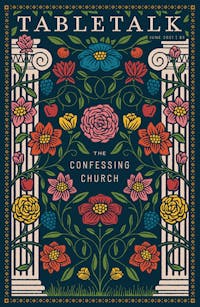
Request your free, three-month trial to Tabletalk magazine. You’ll receive the print issue monthly and gain immediate digital access to decades of archives. This trial is risk-free. No credit card required.
Try Tabletalk NowAlready receive Tabletalk magazine every month?
Verify your email address to gain unlimited access.
Some of my earliest childhood memories center on being with my family in worship on the Lord’s Day. In the Reformed and Presbyterian churches that we attended, expository preaching, hymn-singing, and prayer were fixed elements of worship, as were the historic creeds and confessions of the Christian church. We regularly confessed the Apostles’ Creed and the Nicene Creed—or some particular doctrinal statement out of the Westminster Confession of Faith, Westminster Shorter Catechism, or Heidelberg Catechism. Our pastors cited doctrinal statements from the Westminster Shorter Catechism in their sermons. Though I was unaware of it at the time, these historic doctrinal formulations were shaping my young mind in regard to biblical doctrine, worship, and the Christian life. Over a decade ago, I had the privilege of planting a Reformed and Presbyterian church. I enthusiastically incorporated many of the historic creeds and confessions into our worship service for the express purpose of instruction—as well as for the preservation of the core truths of the Christian faith and the worship of God.
In his 1973 article “Towards a Confession for Tomorrow’s Church,” J.I. Packer insisted that historic creeds and confessions assist the church in carrying out four principal responsibilities—its doxological, declarative, didactic, and disciplinary tasks. Accordingly, churches should make use of these historical doctrinal statements in their worship (doxological), witness (declarative), teaching (didactic), and conservation (disciplinary). Packer proceeded to define how they function in each task:
Their doxological function is to glorify God by setting forth his works of love and putting into words a responsive commitment. Their declarative function is to announce what the communities that espouse them stand for, and so to identify those communities as belonging to Christ’s church, the worldwide fellowship of faith. Their didactic function is to serve as a basis for instruction. Their disciplinary function is to establish the limits of belief within which each confessing body wishes to stay, and so to lay a foundation for whatever forms of doctrinal restriction or direction it may see fit to impose on its clerical and lay members.
The doxological task is the most extensive, since worship involves elements of the declarative, didactic, and disciplinary tasks. Historic creeds and confessions aid the gathered assembly of believers in declaring the core truths of Scripture. They serve the didactic assignment by offering ministers refined doctrinal formulations that assist them in rightly teaching and preaching the whole counsel of God from Scripture. They function as a disciplinary guide, giving leaders and members a doctrinal standard with which to hold one another accountable. Their clear doctrinal definitions act as guardrails to safeguard what is taught and proclaimed in the context of worship. As Packer explained:
Without authorized doctrinal formulae (standards, as Presbyterians have historically called them) the church is clearly at a disadvantage for maintaining its character as “the pillar and bulwark of the truth” (1 Tim. 3:15). Granted, no human formula of faith is complete or final; yet formularies can be true as far as they go, and very useful for excluding false trails and helping each generation to fulfil the task of making as clear as possible what Christianity really is.
When Christians publicly confess the truths that the church has always confessed, God is distinguishing between the church and the world—as well as between true and false churches. Historic doctrinal standards help draw a sharp line between orthodox teaching and false teaching in the articulation of “the faith that was once for all delivered to the saints” (Jude 3).

Ultimately, historic doctrinal formularies support the doxological task of the church by keeping the minds of believers fixed on the core truths about the triune God—who is the object of their worship. They are unified in their Trinitarian and Christological statements. The church’s historic creeds and confessions are preeminently theocentric and Christocentric. Moreover, the seventeenth-century Reformed confessions and catechisms explain, in detail, what it means to worship God according to Scripture. The Westminster Confession of Faith contains an entire chapter dedicated to the subject of Lord’s Day worship (WCF 21), and the Westminster Larger Catechism treats the subject of biblical worship in its exposition of the first four commandments (WLC 105, 108–10, 117).
Since the right worship of God is rooted in the timeless truth of Scripture, churches should eagerly welcome the long-standing historic formulations of biblical truth. Doing so will assist the church in preserving the truth of Christianity and the right worship of God against all perversion of it and opposition to it.
